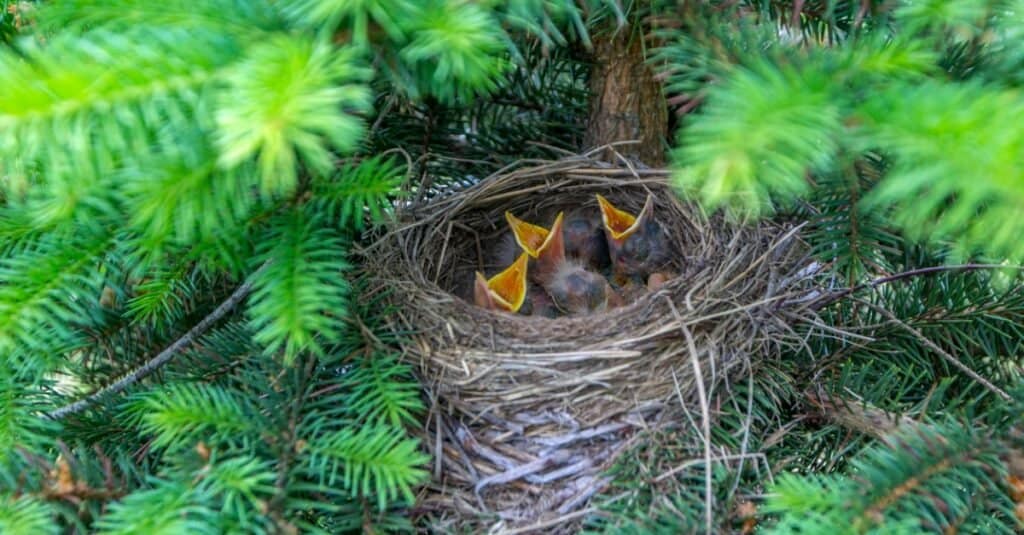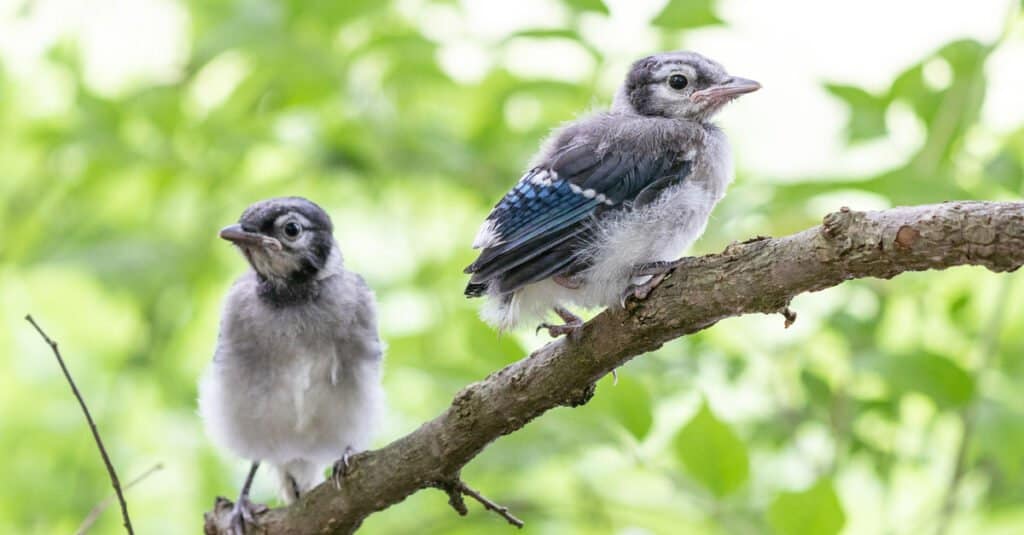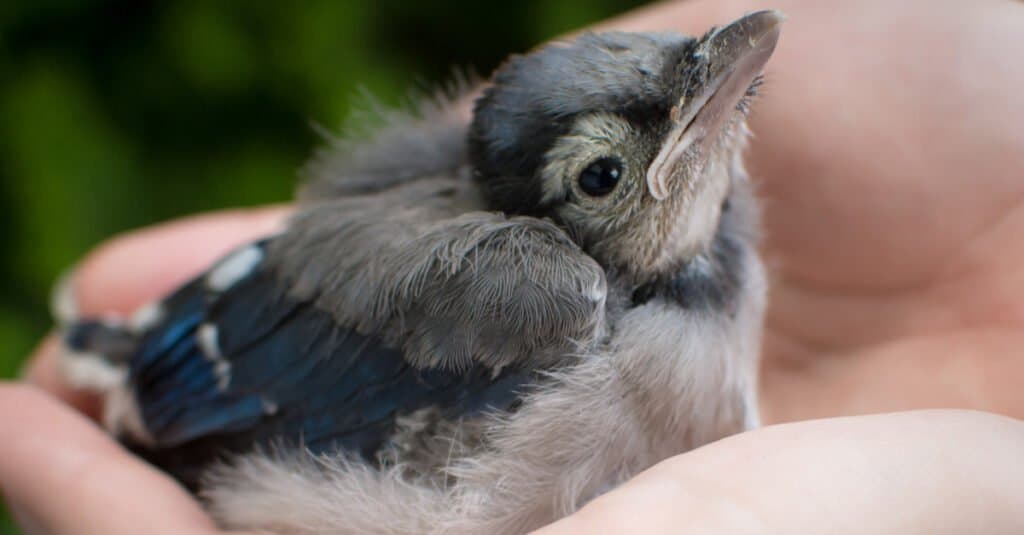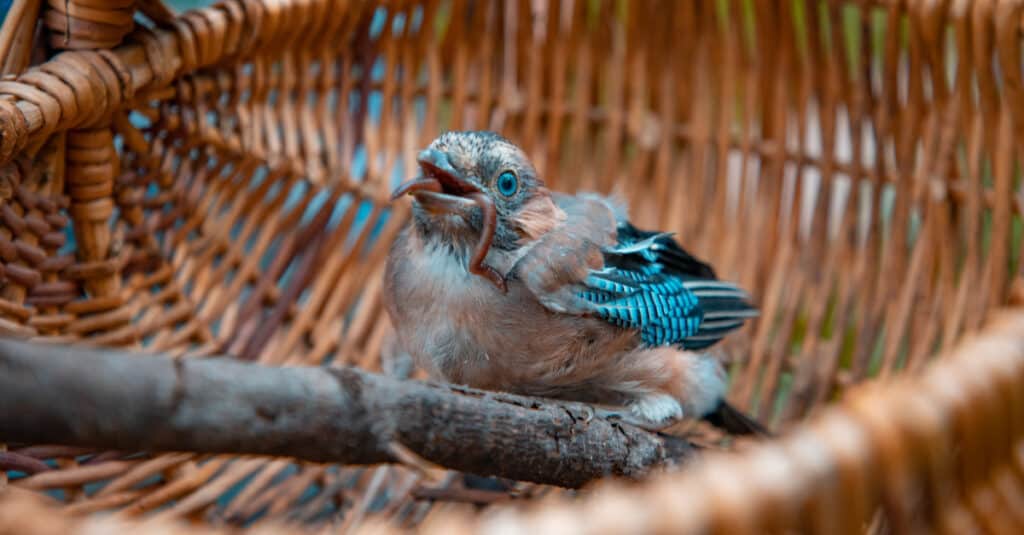Baby blue jay hatchlings are amazing, complex animals. There is no shortage of astounding facts that we can learn about them. For example, did you know that blue jays are not truly blue? What about that their parents are extremely aggressive? Keep reading to learn all about these interesting facts and more!
#1: A Baby Blue Jay is Called a Hatchling!

Baby blue jays are called hatchlings.
©iStock.com/LARISA SHPINEVA
Baby blue jays are baby birds, so it probably comes as no surprise that they are called hatchlings. Like other birds such as baby robins and baby parrots, these astounding creatures hatch from eggs. After a baby blue jay is a few weeks old, it is called a scrub. When it’s learning how to fly, on the other hand, it’s called a fledgling.
#2: Blue Jay Hatchlings Aren’t Blue

Blue jay hatchlings only look blue – they are really brown.
©iStock.com/KendallCarter
Would you believe us if we told you those baby blue jays aren’t actually blue? It’s true, though your eyes are not exactly deceiving you. A baby blue jay’s feathers contain a pigment called melanin, which is brown. The blue color comes from light refraction, which makes these feathers appear blue to the naked eye.
Scientists discovered that when a blue jay’s feathers are crushed, the light is unable to be refracted off of them. It is only in this state that their true brown pigment is apparent. Other brightly-colored birds like cardinals get their color from bright pigments. However, blue animals only make up about 1% of the animal population in the world, and blue jay hatchlings are not a part of this community.
The truth is, a true blue pigment is extremely rare in the wild. A couple of examples of truly blue animals are the blue-spotted salamander and the South American blue poison dart frog.
#3: Mother Blue Jays are Seriously Protective

Mother blue jays fiercely protect their young.
©Amy Lutz/Shutterstock.com
It may come as no surprise to you that mother blue jays are protective. After all, their babies are virtually defenseless and have a long list of predators. However, adult blue jays are notorious for their aggressive nature. So much so, in fact, that blue jay attacks on humans are extremely common.
Scientists say that blue jays are the most protective during May and June. This is because it is during this time that baby blue jay hatchlings are evolving into fledglings. During this stage of a young blue jay’s life, it is venturing out of the nest for the first time. Although these tiny creatures don’t have the safety of their nests, they cannot yet fly. Consequently, they are particularly vulnerable to predators.
The result? Fiercely protective parents. Any time a threat is near their babies, blue jays are known to divebomb. Even so, their small stature and tiny beaks make it virtually impossible for them to cause any real damage. However, this action is usually sufficient enough to scare off potential predators.
#4: Blue Jay Parents Mate for Life

Male and female
blue jays are monogamous.
©Jane4of5/Shutterstock.com
Blue jays are a monogamous species, which means when they choose a mate, they do so for life. In fact, blue jay parents are a formidable pair that both play active roles in their babies’ lives. This is incredible, considering that there is no shortage of animals that never know their father.
The role of a male blue jay doesn’t stop once the female’s eggs are fertilized. Indeed, one of their most important roles to their young is building the nest. Blue jay parents work together to collect materials for nests, such as twigs, roots, and even dried grass. The nest they build is hardy, dense, and cup-shaped.
Once female blue jays have laid their eggs, fathers are essential to the survival of mother and baby blue jays. While the female incubates and watches over her eggs, males collect food and bring it back to nourish their mate’s body. This ensures that the vulnerable eggs have the best chance of survival.
#5: Blue Jay Hatchlings Love to Play

Baby blue jays are energetic and fun creatures.
©realina/Shutterstock.com
Baby blue jay hatchlings are energetic and lively animals. From a young age, they have complex social systems that stay in place for their entire lives. Unlike many other bird species, baby blue jays have strong familial ties and stay in touch with their family members throughout their lives.
Because of their spunky and playful attitudes, it is not a rare sight to see baby blue jays playing in their nests. It is this bonding time that creates the strong familial ties and social constructs that make up a blue jay hatchling’s life.
The photo featured at the top of this post is © Amy Lutz/Shutterstock.com
FAQs (Frequently Asked Questions)
What is a baby blue jay called?
A newly hatched baby blue jay is called a hatchling. When the adorable animals leave their nests and begin to learn how to fly, they are called fledglings.
How much do baby blue jays weigh?
Baby blue jays are an astounding tiny ⅓ of an ounce at birth. However, they grow quickly. By the time they are just under three weeks old, they are nearly the size of their parents.
What do baby blue jays eat?
Like many other bird species, baby blue jays eat a diet that’s similar to their parents. This consists of nuts, berries, and even small scraps of meat!
Where do baby blue jays live?
Baby blue jays are an incredibly adaptive species. They prefer to make their homes in the trees of pine forests. However, they can be found throughout the Southern and Central United States. Typically, they head south for the winter but can be found year-round in some places, like Virginia.
Thank you for reading! Have some feedback for us? Contact the AZ Animals editorial team.






